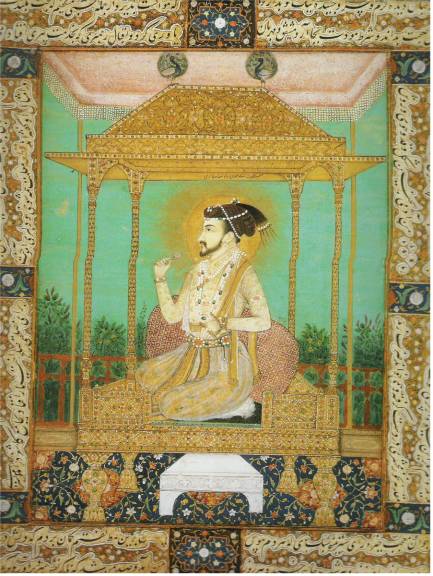The Mughal Empire in India was the richest Islamic dynasty of its time [1]. Shah Jahan, the fourth Mughal emperor (ruled 1628-58), had the most luxurious court of all his predecessors and successors. (He is the Mughal emperor behind the construction of the magnificent Taj Mahal!) Mughal dynasty was known for its rich collection of precious stones. Emperors of that time decorated the walls of their palaces as well as their bodies with rubies, diamonds, and emeralds [2].
A symbol of the grandeur of the Mughal court is undoubtedly the Peacock Throne, which was commissioned by the emperor Shah Jahan. The "jeweled throne" was made entirely of gold and was covered with precious stones [3]. The exquisite stones were selected by Shah Jahan himself from the Mughal treasury. After seven years, the Peacock Throne was complete. A prominent feature from the Peacock Throne was an engraved gem stone; a spinel [4].
Images: [1]
Spinels are a kind of precious stone and they were highly valued at the Mughal treasury. The specific inscribed spinel in question was given to Jahangir (ruled 1605-27), Shah Jahan's father, which was then passed down to Shah Jahan himself. The spinel belonged to Ulugh Beg (before 1449 AD) who engraved his name on it. Ulugh Beg was the grandson of Timur, and the Mughals are descendents of Timur. The spinel also had the name of the Iranian ruler Shah 'Abbas I (dated 1617); who was the ruler who had given the gemstone to Jahangir [4].
Images: [2]
Jahangir's name was added to the spinel, and later included the names of Shah Jahan and his son Awrangzib (ruled 1658-1707). This inscribed spinel, among the thousands of other precious stones covering the Peacock Throne, was the most important [4].
The successors of the great emperors of the Mughals experienced a decline in their empire. In 1738, Nadir Shah of Iran
What happened to the Peacock Throne during that raid?
Alas, the famous jeweled throne was destroyed and all its precious stones were scattered and lost…except for one! The inscribed spinel that was so precious to the Mughal family had luckily survived [4].
And yes! Fortunately for us, it is now part of The al-Sabah Collection.
Sources:
[1] Jonathan Bloom and Sheila Blair, "The Great Empires 1500-1800 AD," Islamic Arts (New York: Phaidon Press Limited, 1997), 288.
[2] John D. La Plante, "The Moslem Conquest of India
[3] Mughal India
[4] Susan Stronge, "Treasury of the World" in Jewels Without Crowns: Mughal Gems in Miniatures, By Lucien de Guise (Malaysia
Images:
[1] Painting of Shah Jahan seated on throne. Delhi, ca. 1800 (a late copy of a lost original ca. 1640). IM. 113-1912. Collection of Victoria & Albert Museum, London, England. http://collections.vam.ac.uk/item/O168139/painting-shah-jahan-on-the-jewelled/?print=1
[2] Cut from spinel, drilled, manually engraved with a diamond stylus, and wheel-cut; weight 249.3 carats. LNS 1660 J. The al-Sabah Collection. http://darmuseum.org.kw/EnGallery.cms?ActiveID=1096&galleryID=87


0 comments:
Post a Comment